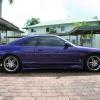GTS-T Badges
Announcements
-
Similar Content
-
Latest Posts
-
Yeah you can. Cable tie the gauge to a windscreen wiper, or run it into the car and hold it with one hand, or have the neighbour's kid run alongside and tell you what it says.
-
I've never understood why this bothers people. Surely you'd be looking at a T3 flanged Garrett style thing, rather than a TD? You're unlikely to push a +T hard enough to need that much fuel. If you're not starting with most of the things you need to do that (ie, the bloody ECU!), you're better off just going Haltech/Link. You wil hate life a lot less. No. Just no. Just turbo it as is.
-
Have you noticed if the squeak changes with temperature or after driving in the rain?
-
By R34_GT to Turbo · Posted
Ok I get you. But isn’t the butterfly intake a headache with the +T? see this is my plan so far but please advise me into the right direction. Nistune Ecu, 1000cc Bosch injectors, TD05 or TD06 Kinugawa turbo using stock rb25det exhuast manifold, walbro fuel pump unsure of model I think it’s 450/460, spitfire coils and sparks to suit and a R35 MAF sensor and boost sensor. I was thinking maybe do a cheap eBay plenum $400-500 or try find a stock det neo intake. I think I’d port match it so it’s getting the full capacity but open to advice please. Thanks -
By GabsReDeal · Posted
The issue now is the 'fuel cut' while driving, and when it happend, it does not stall. This, I did not test the fuel pressure while driving as I cannot with a fuel pressure gauge. I do have Nistune logs, yes. I have also replaced the MAF Sensor. Also related to the FPG Fuel Hanger – I just realized that I need a Deutsch Crimp Tool to crimp some cables for the FPG Fuel Hanger. Need to purchase additional cables as the kit only included 2, which are for the float. FPG has not responded to my emails so far since purchasing. I thought about taking it to someone and having it done professionally, but I am reluctant since everyone I took it to messed up in some way.
-






Recommended Posts
Create an account or sign in to comment
You need to be a member in order to leave a comment
Create an account
Sign up for a new account in our community. It's easy!
Register a new accountSign in
Already have an account? Sign in here.
Sign In Now